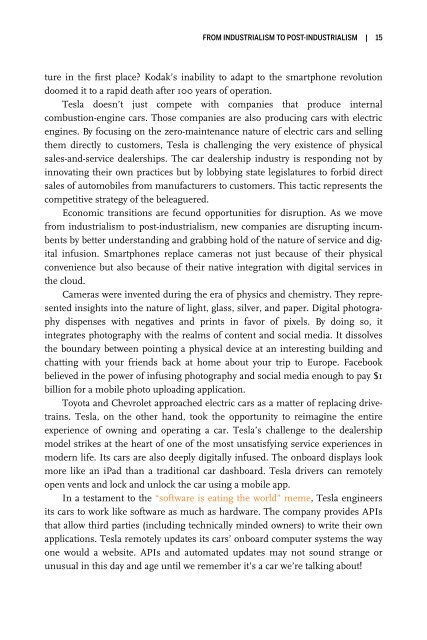Designing Delivery
1Tox6aC
1Tox6aC
Create successful ePaper yourself
Turn your PDF publications into a flip-book with our unique Google optimized e-Paper software.
FROM INDUSTRIALISM TO POST-INDUSTRIALISM | 15<br />
ture in the first place? Kodak’s inability to adapt to the smartphone revolution<br />
doomed it to a rapid death after 100 years of operation.<br />
Tesla doesn’t just compete with companies that produce internal<br />
combustion-engine cars. Those companies are also producing cars with electric<br />
engines. By focusing on the zero-maintenance nature of electric cars and selling<br />
them directly to customers, Tesla is challenging the very existence of physical<br />
sales-and-service dealerships. The car dealership industry is responding not by<br />
innovating their own practices but by lobbying state legislatures to forbid direct<br />
sales of automobiles from manufacturers to customers. This tactic represents the<br />
competitive strategy of the beleaguered.<br />
Economic transitions are fecund opportunities for disruption. As we move<br />
from industrialism to post-industrialism, new companies are disrupting incumbents<br />
by better understanding and grabbing hold of the nature of service and digital<br />
infusion. Smartphones replace cameras not just because of their physical<br />
convenience but also because of their native integration with digital services in<br />
the cloud.<br />
Cameras were invented during the era of physics and chemistry. They represented<br />
insights into the nature of light, glass, silver, and paper. Digital photography<br />
dispenses with negatives and prints in favor of pixels. By doing so, it<br />
integrates photography with the realms of content and social media. It dissolves<br />
the boundary between pointing a physical device at an interesting building and<br />
chatting with your friends back at home about your trip to Europe. Facebook<br />
believed in the power of infusing photography and social media enough to pay $1<br />
billion for a mobile photo uploading application.<br />
Toyota and Chevrolet approached electric cars as a matter of replacing drivetrains.<br />
Tesla, on the other hand, took the opportunity to reimagine the entire<br />
experience of owning and operating a car. Tesla’s challenge to the dealership<br />
model strikes at the heart of one of the most unsatisfying service experiences in<br />
modern life. Its cars are also deeply digitally infused. The onboard displays look<br />
more like an iPad than a traditional car dashboard. Tesla drivers can remotely<br />
open vents and lock and unlock the car using a mobile app.<br />
In a testament to the “software is eating the world” meme, Tesla engineers<br />
its cars to work like software as much as hardware. The company provides APIs<br />
that allow third parties (including technically minded owners) to write their own<br />
applications. Tesla remotely updates its cars’ onboard computer systems the way<br />
one would a website. APIs and automated updates may not sound strange or<br />
unusual in this day and age until we remember it’s a car we’re talking about!


